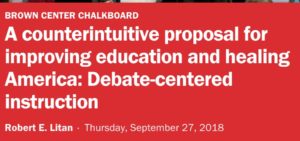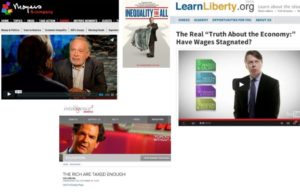High School Courses and Claims Should Be Debated
Brookings Institution’s Robert Litan offers A counterintuitive proposal for improving education and healing America: Debate-centered instruction (Brookings, September 27, 2018). Litan begins with a paragraph about current political and economic challenges then begins his case for debate instruction:
Political leaders, academic and think tank scholars, journalists, and pundits across the political spectrum have offered all sorts of remedies for these political and economic ills. I have a very different prescription, not only to begin to heal our political and economic rifts, but to improve American education and students’ interest in learning: Require all students in high school, or earlier, to take one semester of debate, and ideally incorporate debate into humanities and possibly some science classes as well.
Litan explains “the partisan shouting matches we see on cable TV”:
…are not the skills taught by competitive debating in school, namely how to: research; think critically and do it on your feet; back up arguments with evidence (not fake news!); work collaboratively with partners; speak persuasively in a civil fashion; and, perhaps most importantly, being able to argue both sides of most any issue or subject.
Litan makes the case for active-learning and students engaging the many sides of public policy debates. Developing research and speaking skills
The importance of research and thinking critically is illustrated too in Mr. Litan’s first paragraph. He says the country has split into “red and blue tribes” finding it increasingly harder to talk to each other. And he claims:
Economically, although the economy’s expansion is in its ninth year, the prospects for upward mobility—earning more than your parents, as one measure—have diminished markedly over several decades, due to the widening of income and wealth inequalities not seen since before the Great Depression. The result is anxiety, anger, and incivility that has infected our politics and our lives.
This claim could provide a good debate topic by encouraging students to define terms, research, and examine claims of decline and growing income inequality critically. There is often much more to the story. Average–median–incomes could be stagnant or declining, but millions more women and immigrants joining the workforce over the last three decades could account for that. Incomes could be rising for most people. (Immigrants earn more in the U.S. than in the countries they came from, but their initial wages are often lower, so the pull the median, or average down.)
Many scholars and think tanks have been skeptical of claims about increasing income inequality. Here is a PBS NewsHour article, Is increasing income inequality a fact or a myth? (March 29, 2018) citing recent research:
You thought income inequality was rising dramatically, right? Well, so did I. In fact, maybe you thought so in part because I and journalists like me have been reporting it as fact, for decades. But maybe we’re wrong — all of us.
That’s the startling conclusion of a new academic paper making the rounds of the economics profession, contradicting conventional wisdom: that incomes of the top 10 percent, 1 percent and especially the tippy-top .1 percent, have been pulling away from the rest of Americans like an iceberg calving in Antarctica. The gap has risen some, says the paper. But nowhere near as much as alleged.
The reality is that incomes, when benefits are included, have been increasing in recent decades, and income inequality hasn’t been increasing much:
“By tax base changes and missing income sources,” the authors argue. And the changes and sources make a huge difference. They continue: “Accounting for these limitations reduces the increase in top one percent income shares by two-thirds.”
Two-thirds? That’s a whole lot of reducing. And the authors, both of them tax experts who have worked for Congress under Democrats and Republicans alike, don’t stop there.
Reporting about the “middle class” shrinking, falling behind, or being “hollowed out,” is misleading. The middle class is shrinking due in part because incomes have increased for millions who have moved up. The good news about the hollowing out of America’s middle class (Quartz, August 2, 2017) explains:
Pew research estimates that in the past few decades, the income distribution has become both wider and flatter. The richest 1% have seen their incomes grow much faster than everyone else, while the poorest groups have fallen further behind. Where does that leave the middle class? According to Pew, some became poorer and slipped into lower income classes, but a larger share of the disappearing middle class in fact joined the upper classes.
Also U.S. Cost of Living and Wage Stagnation, 1979-2015 (HumanProgress, August 12, 2017) notes inflation-adjusted average wages haven’t increased much:
Looking at the average hourly earnings, however, ignores at least three very important factors: expansion of non-wage benefits, fall in the price of consumer goods and rise in price of services, such as education and healthcare.
Better reporting on “wage stagnation” and income inequality claims could reduce populist and nationalist antagonism, from across the political spectrum, and anger about immigration and international trade.
Misguided reporting makes it easier for people to believe immigrants and trade with Mexico and China have hurt “middle-class” Americans, keeping wages down and damaging U.S. manufacturing.
See, for example, Inaccurate reporting on social inequality makes matters worse (The Hill, October 8, 2018), co-authored by Nobel Laureate James Heckman (2000 shared Nobel Memorial Prize in Economic Sciences). The article is critical of recent New York Times and other stories on racism and income inequality, noting what wasn’t reported:
Skill disparities, family dynamics, early childhood development and incarceration effects were all but left out of the New York Times coverage and the academic report itself, even though there exists a wide body of scholarly work on the mechanisms that produce economic success and the factors influencing disparities between various populations.
Consilience between previous academic studies with some of the new wave of mobility studies is needed. The crucial role of the family in building the early skills for success highlights the importance of eliminating the marriage penalties in the tax code and various welfare programs that disincentivize the formation of long-term stable marriages and families.
Meaningful criminal justice reforms that reduce unnecessary incarceration must be a part of any effort to increase upward economic mobility.
Discussion and debate can help us better understand economic reality and dynamics. Economies and societies advance and decline, progress and regress in various complex and interconnected ways. For example, people grow old. Maybe a part of increasing hostility in American is caused by people getting older on average, and grumpier.
So some thoughts on age demographics. For the 132 million living in the U.S. in 1940, the median age was 29. For the 327 million living in the U.S. now, the median age has risen to almost 38.
America is home to nearly 200 million more people than at the end of the Great Depression, and they are on average almost 10 years older.
Back to the importance of debate: students should consider the various data, claims, and discussion about income inequality sympathetically, hold various views and narratives out to consider, discuss and reflect upon.

Then, with further research, students can look for weaknesses and fallacies.
The Campaign Against Income Inequality is a past post on a 2014 value debate topic: “Resolved: In the realm of economics, freedom ought to be valued above equity.” The post includes links to an online debate and videos by economists Robert Reich and Don Boudreaux, each offering strikingly contrasting views at income inequality.
